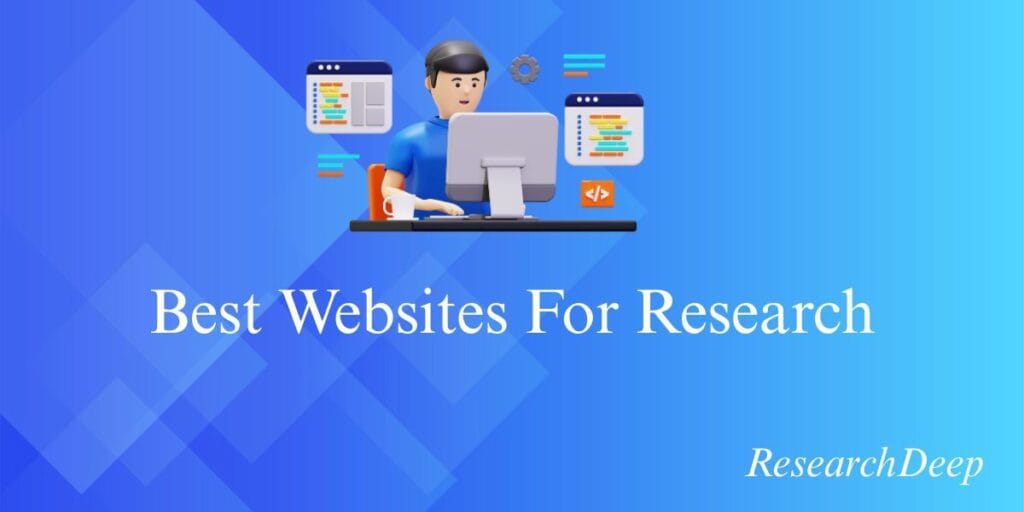Introduction
Choosing the best websites for research is one of the most strategic decisions for any Master’s or PhD scholar. With millions of papers published annually, academic discovery now depends on using the academic databases and search engines for breadth, accuracy, and accessibility.
Using broad engines like Google Scholar and Semantic Scholar cast wide nets across disciplines, while field-specific databases like PubMed or IEEE Xplore deliver precision and peer-reviewed credibility.
Open-access aggregators such as DOAJ, CORE, and arXiv make research more inclusive, which is essential for scholars without institutional access.
This guide explores the top research websites, explaining what each does best, where they fall short, and how to use them strategically in your workflow.
Table of Contents
Overview
Broad academic search
Field-specific / peer-reviewed
Open access & preprints
1. Broad Academic Search Platforms
1.1 Google Scholar
URL: https://scholar.google.com
Overview: Google Scholar indexes scholarly literature from across disciplines—journal articles, theses, books, abstracts, and conference papers. It is ideal for an initial scan of existing research.
Why researchers use it:
- This database offers the widest multidisciplinary coverage of any freely available academic resource.
- Features “Cited by” and “Related articles” links to trace citation patterns.
- Integrates with institutional libraries and citation managers like Zotero or EndNote.
Limitations:
- Not all indexed materials are from peer-reviewed journals (theses, preprints, reports).
- Inconsistent metadata and citation formats.
Pro tip: Link your institution’s library in settings to access subscription-based full texts directly from Google Scholar.
(Martín-Martín et al., 2018; Gusenbauer, 2019)
1.2 Semantic Scholar
URL: https://www.semanticscholar.org
Overview: Developed by the Allen Institute for AI, Semantic Scholar uses machine learning to identify key topics, related works, and citation networks.
Why researchers use it:
- AI summarization highlights the key contributions of each paper.
- Citation graphs visualize relationships between studies.
- This feature allows filtering by field of study, publication year, and open access.
Limitations:
- Smaller coverage than Google Scholar, particularly for the humanities.
- AI summaries occasionally omit methodological nuances.
Pro tip: Use both Google Scholar (for breadth) and Semantic Scholar (for connection insights) when preparing a literature review.
2. Field-Specific Research Databases
2.1 PubMed
URL: https://pubmed.ncbi.nlm.nih.gov
Overview: PubMed, managed by the U.S. National Library of Medicine, indexes over 36 million citations in biomedicine and life sciences.
Why researchers use it:
- Access to MEDLINE’s controlled vocabulary (MeSH) for structured searching.
- Links directly to PubMed Central (PMC) for free full-text articles.
- Advanced filters: study type, age group, publication date, and species.
Limitations:
- Primarily abstracts—full-text access often requires subscriptions.
- Focused narrowly on biomedical disciplines.
Pro tip: Use “Clinical Queries” in PubMed to find systematic reviews or evidence-based summaries efficiently.
(PubMed, NIH, 2025)
2.2 IEEE Xplore
URL: https://ieeexplore.ieee.org
Overview: IEEE Xplore is the authoritative source for engineering, computer science, and electronics research, containing over five million documents.
Why researchers use it:
- Comprehensive coverage of peer-reviewed conference proceedings and IEEE journals.
- This is useful for up-to-date technical standards and protocols.
Limitations:
- Subscription-based; limited free content.
- Less coverage of non-STEM fields.
Pro tip: For new algorithms or system architectures, prioritize conference papers, which often precede journal publication.
(IEEE Xplore, 2025)
3. Open-Access & Preprint Repositories
3.1 Directory of Open Access Journals (DOAJ)
URL: https://doaj.org
Overview: DOAJ indexes over 19,000 peer-reviewed open-access journals across all academic disciplines.
Why researchers use it:
- This process ensures journals meet transparent peer-review and ethical standards.
- Ideal for discovering freely available, high-quality research.
Pro tip: Filter results by license type (e.g., CC BY) to ensure unrestricted reuse.
(DOAJ, 2025)
3.2 CORE
URL: https://core.ac.uk
Overview: CORE aggregates millions of open-access papers from institutional repositories worldwide, emphasizing accessibility and global inclusion.
Why researchers use it:
- Enables download of full-text PDFs directly from repositories.
- Aggregates content from 10,000+ data providers globally.
Limitations:
- Duplicate entries may occur due to repository overlap.
- Metadata quality varies.
Pro tip: Use CORE’s advanced filters by repository or publication year for cleaner results.
(CORE, 2025)
3.3 arXiv
URL: https://arxiv.org
Overview: arXiv hosts over 2.5 million preprints in physics, mathematics, computer science, and quantitative biology.
Why researchers use it:
- Access cutting-edge studies before peer review.
- Frequent updates with version tracking.
Limitations:
- Articles are not peer-reviewed.
- Concentrated in STEM disciplines.
Pro tip: Always check whether the preprint has a peer-reviewed DOI version before citing.
(arXiv, 2025)
4. Journals & Digital Libraries
4.1 JSTOR
Overview: JSTOR is a digital library providing archival access to journals, books, and primary sources—especially strong in the humanities and social sciences.
Why researchers use it:
- Back-issue access (“moving wall”) for historical research.
- Useful for interdisciplinary and historical perspectives.
Limitations:
- Recent issues are often under embargo.
- Requires institutional subscription for most content.
Pro tip: Many universities in India offer free JSTOR access through the INFLIBNET consortium.
(JSTOR, 2025)
4.2 ScienceDirect
URL: https://www.sciencedirect.com
Overview: Hosted by Elsevier, ScienceDirect provides full-text access to over 2,800 scientific journals and 40,000+ eBooks in STEM fields.
Why researchers use it:
- Deep coverage in chemistry, materials science, and medicine.
- Smart “Topic Pages” powered by Scopus metadata.
Limitations:
- Subscription required for full-text access.
- Coverage favors Elsevier-published journals.
Pro tip: Use ScienceDirect’s “Recommended articles” sidebar to discover related studies.
(Elsevier, 2025)
📊 Comparison Table
| Website | Best For | Acess | Coverage Strength | Peer Review | Ideal For |
|---|---|---|---|---|---|
| Google Scholar | Broad literature search | Free | Multidisciplinary | Mixed | Early-stage topic exploration. |
| Semantic Scholar | AI-driven relevance | Free | Broad STEM | Mixed | Mapping influence networks. |
| PubMed | Biomedical sciences | Free | MEDLINE + PMC | Peer-reviewed | Life science & medical research. |
| IEEE Xplore | Engineering & CS | Subscription | Technical & applied | Peer-reviewed | Engineers & tech PhDs. |
| DOAJ | Open access journals | Free | Curated OA | Peer-reviewed | Ethical, OA publishing. |
| CORE | Repository aggregation | Free | OA archives | Mixed | Global full-text retrieval. |
| arXiv | Preprints (STEM) | Free | Preprints only | Not reviewed | Early-stage research. |
| JSTOR | Archival & humanities | Subscription | Historical issues | Peer-reviewed | Humanities & social sciences. |
| ScienceDirect | STEM full text | Subscription | Elsevier corpus | Peer-reviewed | Advanced STEM research. |
5. How to Combine These Websites Effectively
Efficient research rarely relies on a single platform. The best results emerge from a layered search approach, where each stage builds on the previous one. Begin broadly to gain orientation, then narrow to specialized databases for depth, and finally verify accessibility through open-access repositories.
This multi-platform strategy ensures your findings are comprehensive, peer-reviewed, and ethically sourced.
| Research Stage | Recommended Websites | Purpose |
|---|---|---|
| Initial exploration | Google Scholar, Semantic Scholar | Identify emerging trends, top-cited works, and potential research gaps across disciplines. |
| Discipline-specific deep dive | PubMed, IEEE Xplore | Retrieve curated, peer-reviewed literature relevant to your specific field of study. |
| Full-text and accessibility check | DOAJ, CORE | Locate open-access versions of journal articles and ensure compliance with research sharing policies. |
| Latest developments | arXiv | Track preprints and ongoing discussions in fast-evolving scientific domains such as physics, AI, and computational biology. |
| Archival review | JSTOR, ScienceDirect | Study legacy or foundational works for theoretical grounding, historical context, or longitudinal comparisons. |
FAQs
Which is the most reliable research website?
Reliability depends on the field: PubMed is authoritative for biomedical sciences, and IEEE Xplore is authoritative for technical sciences. For general use, pairing Google Scholar (coverage) with Semantic Scholar (accuracy) yields the best balance.
How do I know if a research article is peer-reviewed?
To tell if an article is peer-reviewed, check the publisher’s website or DOAJ listing. Tools like Ulrichsweb or the journal’s “About” page confirm peer-review status.
How can I find open-access journal articles?
Use the Directory of Open Access Journals (DOAJ) or CORE, which aggregate freely available papers meeting open-access standards (Creative Commons licenses).
What are the best free websites for academic research?
The best free academic research websites include Google Scholar, Semantic Scholar, PubMed, CORE, DOAJ, and arXiv. These provide access to peer-reviewed papers, open-access repositories, and preprints without subscription barriers.
Conclusion
No single platform satisfies all research needs. Instead, effective scholars combine breadth, precision, and openness.
- Begin with Google Scholar and Semantic Scholar for coverage and mapping.
- Narrow down using PubMed (biomedical) or IEEE Xplore (engineering).
- Ensure accessibility through DOAJ, CORE, and arXiv.
- Draw historical or full-text depth from JSTOR and ScienceDirect.
Together, these tools form a complete academic discovery ecosystem, balancing convenience, quality, and inclusivity.
🧩 Key Takeaway
Build a two-tier strategy:
- Tier 1 – Discovery: Google Scholar + Semantic Scholar
- Tier 2 – Verification & Access: PubMed / IEEE Xplore + DOAJ / CORE / arXiv
Continually assess peer-review status, publication date, and DOI links before citing. Prefer open-access sources for transparency, reproducibility, and audience reach.
References
- Martín-Martín, A., Orduna-Malea, E., Thelwall, M., & Delgado López-Cózar, E. (2018). Google Scholar, Web of Science, and Scopus: A systematic comparison of citations in 252 subject categories. Journal of Informetrics, 12(4), 1160–1177. https://doi.org/10.1016/j.joi.2018.09.002
- Gusenbauer, M. (2019). Google Scholar to overshadow them all? Comparing the academic search systems. Scientometrics. https://doi.org/10.1007/s11192-018-2958-5
- PubMed – National Library of Medicine (NIH). (2025). About PubMed. Retrieved from https://pubmed.ncbi.nlm.nih.gov/about/
- IEEE Xplore Digital Library. (2025). About the IEEE Xplore Digital Library. https://innovate.ieee.org/about-the-ieee-xplore-digital-library/
- Directory of Open Access Journals (DOAJ). (2025). https://doaj.org/
- CORE (Open Access Repository Network). (2025). https://core.ac.uk/
- arXiv Preprint Repository. (2025). https://arxiv.org/
- JSTOR Digital Library. (2025). https://www.jstor.org/
- Elsevier – ScienceDirect. (2025). https://www.sciencedirect.com/




